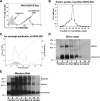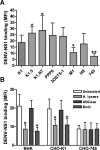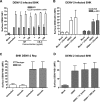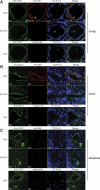Secreted NS1 of dengue virus attaches to the surface of cells via interactions with heparan sulfate and chondroitin sulfate E
- PMID: 18052531
- PMCID: PMC2092380
- DOI: 10.1371/journal.ppat.0030183
Secreted NS1 of dengue virus attaches to the surface of cells via interactions with heparan sulfate and chondroitin sulfate E
Abstract
Dengue virus (DENV) nonstructural protein-1 (NS1) is a secreted glycoprotein that is absent from viral particles but accumulates in the supernatant and on the plasma membrane of cells during infection. Immune recognition of cell surface NS1 on endothelial cells has been hypothesized as a mechanism for the vascular leakage that occurs during severe DENV infection. However, it has remained unclear how NS1 becomes associated with the plasma membrane, as it contains no membrane-spanning sequence motif. Using flow cytometric and ELISA-based binding assays and mutant cell lines lacking selective glycosaminoglycans, we show that soluble NS1 binds back to the surface of uninfected cells primarily via interactions with heparan sulfate and chondroitin sulfate E. DENV NS1 binds directly to the surface of many types of epithelial and mesenchymal cells yet attaches poorly to most peripheral blood cells. Moreover, DENV NS1 preferentially binds to cultured human microvascular compared to aortic or umbilical cord vein endothelial cells. This binding specificity was confirmed in situ as DENV NS1 bound to lung and liver but not intestine or brain endothelium of mouse tissues. Differential binding of soluble NS1 by tissue endothelium and subsequent recognition by anti-NS1 antibodies could contribute to the selective vascular leakage syndrome that occurs during severe secondary DENV infection.
Conflict of interest statement
Figures









References
-
- Gubler DJ. Epidemic dengue/dengue hemorrhagic fever as a public health, social, and economic problem in the 21st century. Trends Microbiol. 2002;10:100–103. - PubMed
-
- Sangkawibha N, Rojanasuphot S, Ahandrik S, Viriyapongse S, Jatanasen S, et al. Risk factors in dengue shock syndrome: a prospective epidemiologic study in Rayong, Thailand. I. The 1980 outbreak. Am J Epidemiol. 1984;120:653–669. - PubMed
-
- Guzman MG, Kouri G, Valdes L, Bravo J, Alvarez M, et al. Epidemiologic studies on dengue in Santiago de Cuba, 1997. Am J Epidemiol. 2000;152:793–799. 804. discussion. - PubMed
-
- Nimmannitya S. Clinical spectrum and management of dengue haemorrhagic fever. Southeast Asian J Trop Med Public Health. 1987;18:392–397. - PubMed
-
- Rothman AL, Ennis FA. Immunopathogenesis of dengue hemorrhagic fever. Virology. 1999;257:1–6. - PubMed
Publication types
MeSH terms
Substances
Grants and funding
LinkOut - more resources
Full Text Sources
Research Materials

